Analyzing Gender Roles and Discrimination in Australian Cinema
VerifiedAdded on 2023/06/04
|9
|2543
|92
Essay
AI Summary
This essay examines gender discrimination in Australian cinema through the analysis of two Australian films: "Sunday Too Far Away" (1975) and "The Daughter" (2015). The essay begins with an introduction to the influence of cinema on society and the roles of men and women in film. It then delves into the portrayal of gender roles, societal issues, and the social status of men and women in both movies, highlighting the differences between the two time periods. "Sunday Too Far Away" showcases the harsh working conditions of men and their neglect of family life, and the limited roles of women. "The Daughter" explores complex family dynamics, infidelity, and the stereotypes faced by women. The essay concludes by comparing the movies, emphasizing the persistence of gender discrimination despite societal changes, and how the films reflect the evolving representations of men and women in Australian cinema. The essay uses Harvard style referencing and includes scholarly sources.
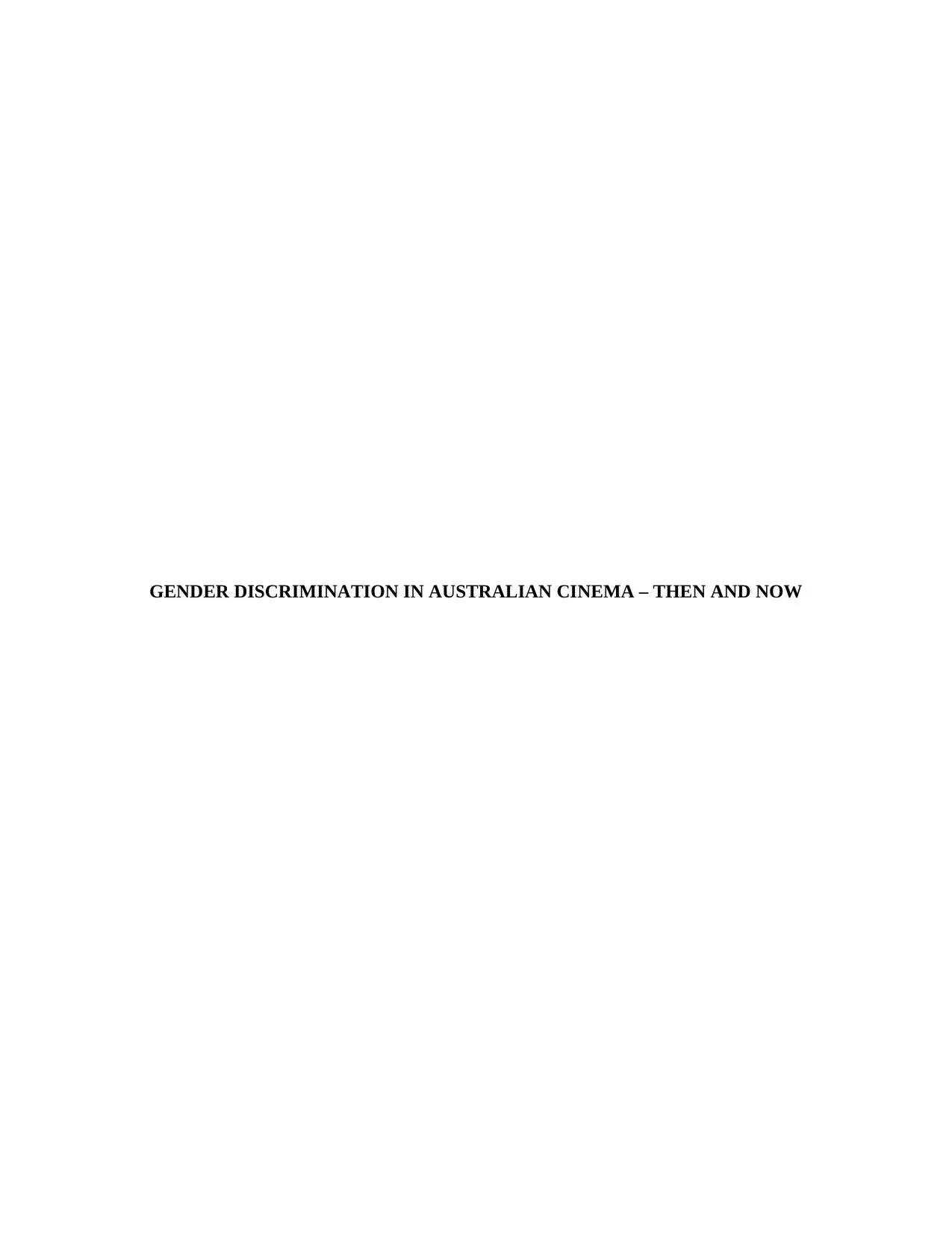
GENDER DISCRIMINATION IN AUSTRALIAN CINEMA – THEN AND NOW
Paraphrase This Document
Need a fresh take? Get an instant paraphrase of this document with our AI Paraphraser
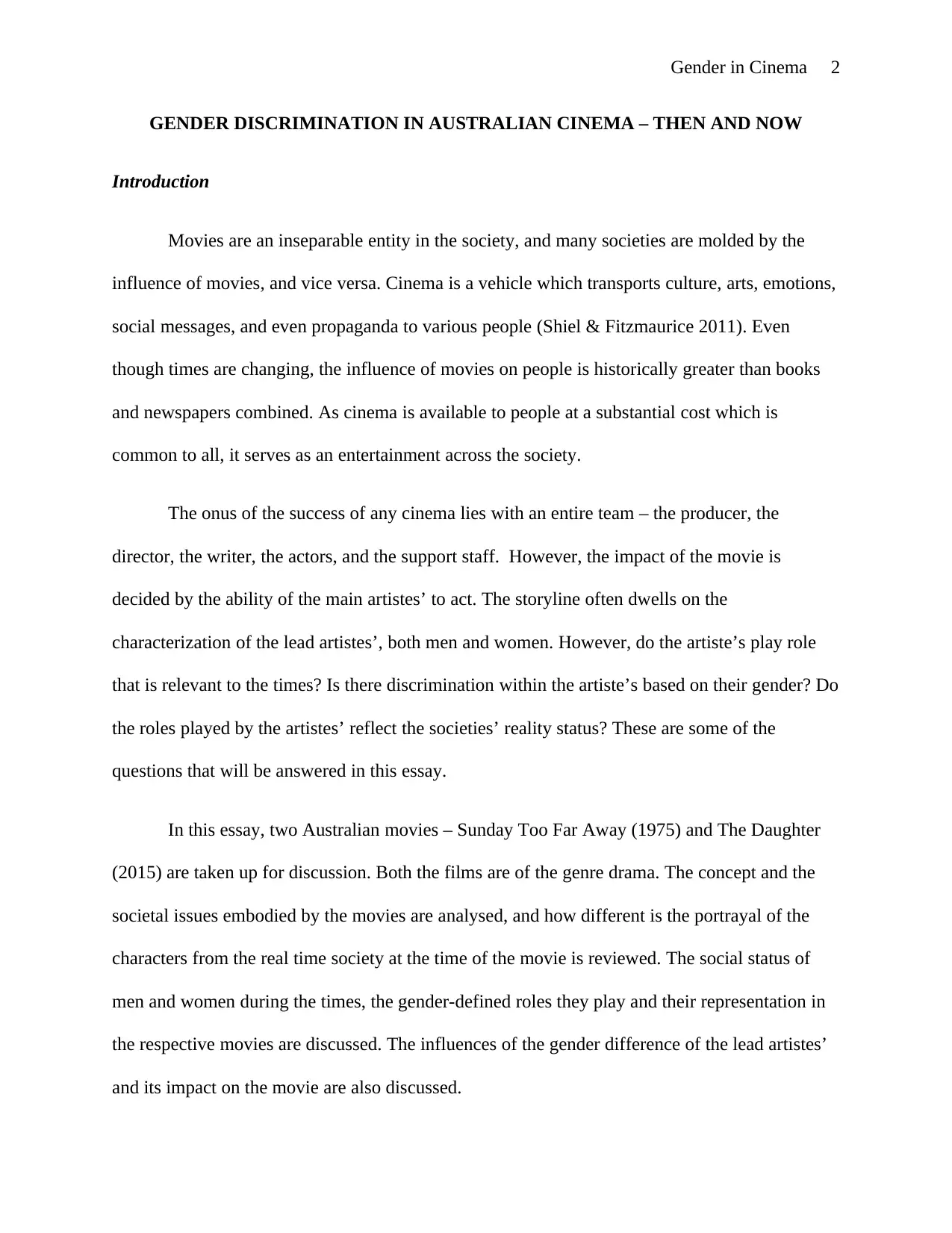
Gender in Cinema 2
GENDER DISCRIMINATION IN AUSTRALIAN CINEMA – THEN AND NOW
Introduction
Movies are an inseparable entity in the society, and many societies are molded by the
influence of movies, and vice versa. Cinema is a vehicle which transports culture, arts, emotions,
social messages, and even propaganda to various people (Shiel & Fitzmaurice 2011). Even
though times are changing, the influence of movies on people is historically greater than books
and newspapers combined. As cinema is available to people at a substantial cost which is
common to all, it serves as an entertainment across the society.
The onus of the success of any cinema lies with an entire team – the producer, the
director, the writer, the actors, and the support staff. However, the impact of the movie is
decided by the ability of the main artistes’ to act. The storyline often dwells on the
characterization of the lead artistes’, both men and women. However, do the artiste’s play role
that is relevant to the times? Is there discrimination within the artiste’s based on their gender? Do
the roles played by the artistes’ reflect the societies’ reality status? These are some of the
questions that will be answered in this essay.
In this essay, two Australian movies – Sunday Too Far Away (1975) and The Daughter
(2015) are taken up for discussion. Both the films are of the genre drama. The concept and the
societal issues embodied by the movies are analysed, and how different is the portrayal of the
characters from the real time society at the time of the movie is reviewed. The social status of
men and women during the times, the gender-defined roles they play and their representation in
the respective movies are discussed. The influences of the gender difference of the lead artistes’
and its impact on the movie are also discussed.
GENDER DISCRIMINATION IN AUSTRALIAN CINEMA – THEN AND NOW
Introduction
Movies are an inseparable entity in the society, and many societies are molded by the
influence of movies, and vice versa. Cinema is a vehicle which transports culture, arts, emotions,
social messages, and even propaganda to various people (Shiel & Fitzmaurice 2011). Even
though times are changing, the influence of movies on people is historically greater than books
and newspapers combined. As cinema is available to people at a substantial cost which is
common to all, it serves as an entertainment across the society.
The onus of the success of any cinema lies with an entire team – the producer, the
director, the writer, the actors, and the support staff. However, the impact of the movie is
decided by the ability of the main artistes’ to act. The storyline often dwells on the
characterization of the lead artistes’, both men and women. However, do the artiste’s play role
that is relevant to the times? Is there discrimination within the artiste’s based on their gender? Do
the roles played by the artistes’ reflect the societies’ reality status? These are some of the
questions that will be answered in this essay.
In this essay, two Australian movies – Sunday Too Far Away (1975) and The Daughter
(2015) are taken up for discussion. Both the films are of the genre drama. The concept and the
societal issues embodied by the movies are analysed, and how different is the portrayal of the
characters from the real time society at the time of the movie is reviewed. The social status of
men and women during the times, the gender-defined roles they play and their representation in
the respective movies are discussed. The influences of the gender difference of the lead artistes’
and its impact on the movie are also discussed.
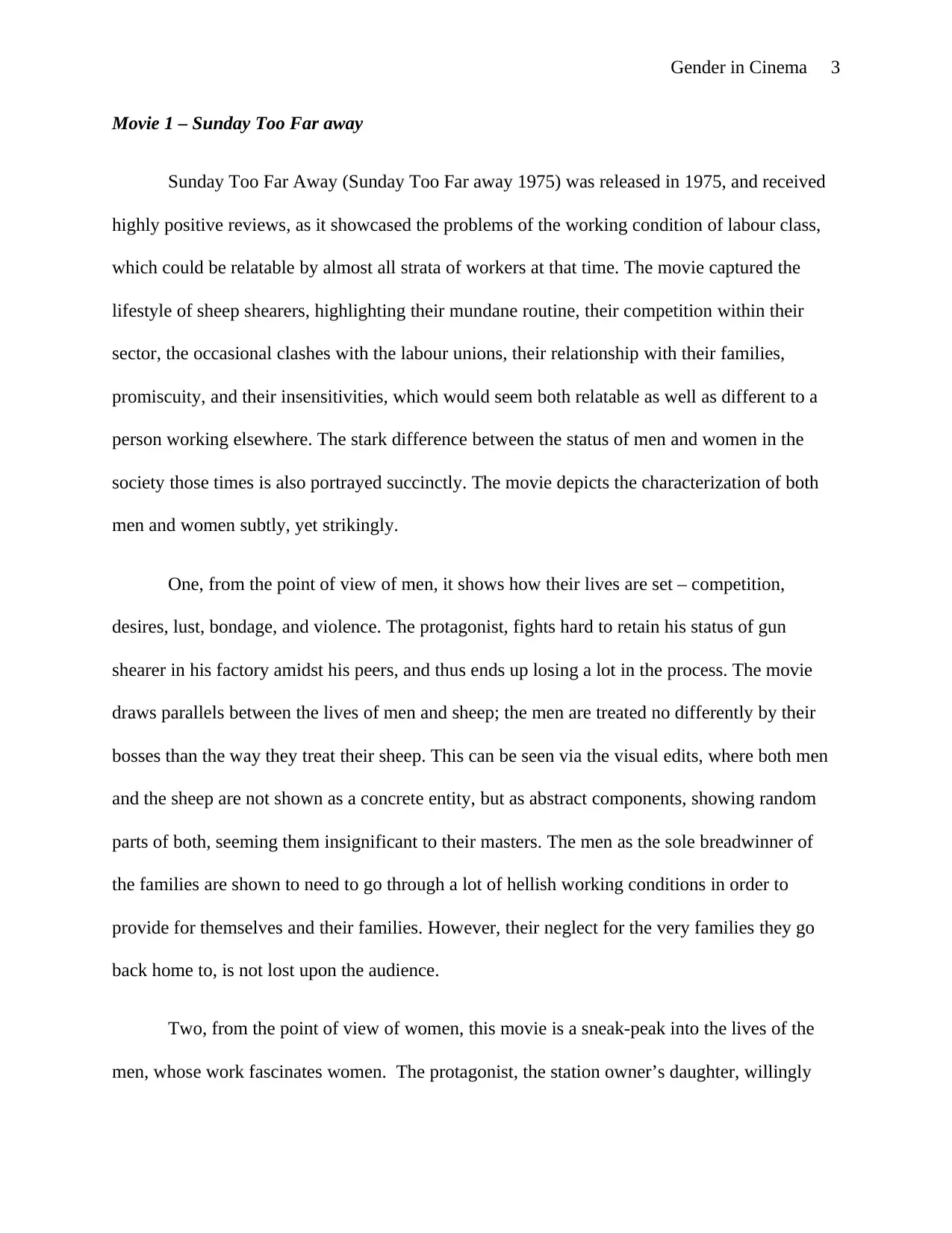
Gender in Cinema 3
Movie 1 – Sunday Too Far away
Sunday Too Far Away (Sunday Too Far away 1975) was released in 1975, and received
highly positive reviews, as it showcased the problems of the working condition of labour class,
which could be relatable by almost all strata of workers at that time. The movie captured the
lifestyle of sheep shearers, highlighting their mundane routine, their competition within their
sector, the occasional clashes with the labour unions, their relationship with their families,
promiscuity, and their insensitivities, which would seem both relatable as well as different to a
person working elsewhere. The stark difference between the status of men and women in the
society those times is also portrayed succinctly. The movie depicts the characterization of both
men and women subtly, yet strikingly.
One, from the point of view of men, it shows how their lives are set – competition,
desires, lust, bondage, and violence. The protagonist, fights hard to retain his status of gun
shearer in his factory amidst his peers, and thus ends up losing a lot in the process. The movie
draws parallels between the lives of men and sheep; the men are treated no differently by their
bosses than the way they treat their sheep. This can be seen via the visual edits, where both men
and the sheep are not shown as a concrete entity, but as abstract components, showing random
parts of both, seeming them insignificant to their masters. The men as the sole breadwinner of
the families are shown to need to go through a lot of hellish working conditions in order to
provide for themselves and their families. However, their neglect for the very families they go
back home to, is not lost upon the audience.
Two, from the point of view of women, this movie is a sneak-peak into the lives of the
men, whose work fascinates women. The protagonist, the station owner’s daughter, willingly
Movie 1 – Sunday Too Far away
Sunday Too Far Away (Sunday Too Far away 1975) was released in 1975, and received
highly positive reviews, as it showcased the problems of the working condition of labour class,
which could be relatable by almost all strata of workers at that time. The movie captured the
lifestyle of sheep shearers, highlighting their mundane routine, their competition within their
sector, the occasional clashes with the labour unions, their relationship with their families,
promiscuity, and their insensitivities, which would seem both relatable as well as different to a
person working elsewhere. The stark difference between the status of men and women in the
society those times is also portrayed succinctly. The movie depicts the characterization of both
men and women subtly, yet strikingly.
One, from the point of view of men, it shows how their lives are set – competition,
desires, lust, bondage, and violence. The protagonist, fights hard to retain his status of gun
shearer in his factory amidst his peers, and thus ends up losing a lot in the process. The movie
draws parallels between the lives of men and sheep; the men are treated no differently by their
bosses than the way they treat their sheep. This can be seen via the visual edits, where both men
and the sheep are not shown as a concrete entity, but as abstract components, showing random
parts of both, seeming them insignificant to their masters. The men as the sole breadwinner of
the families are shown to need to go through a lot of hellish working conditions in order to
provide for themselves and their families. However, their neglect for the very families they go
back home to, is not lost upon the audience.
Two, from the point of view of women, this movie is a sneak-peak into the lives of the
men, whose work fascinates women. The protagonist, the station owner’s daughter, willingly
⊘ This is a preview!⊘
Do you want full access?
Subscribe today to unlock all pages.

Trusted by 1+ million students worldwide
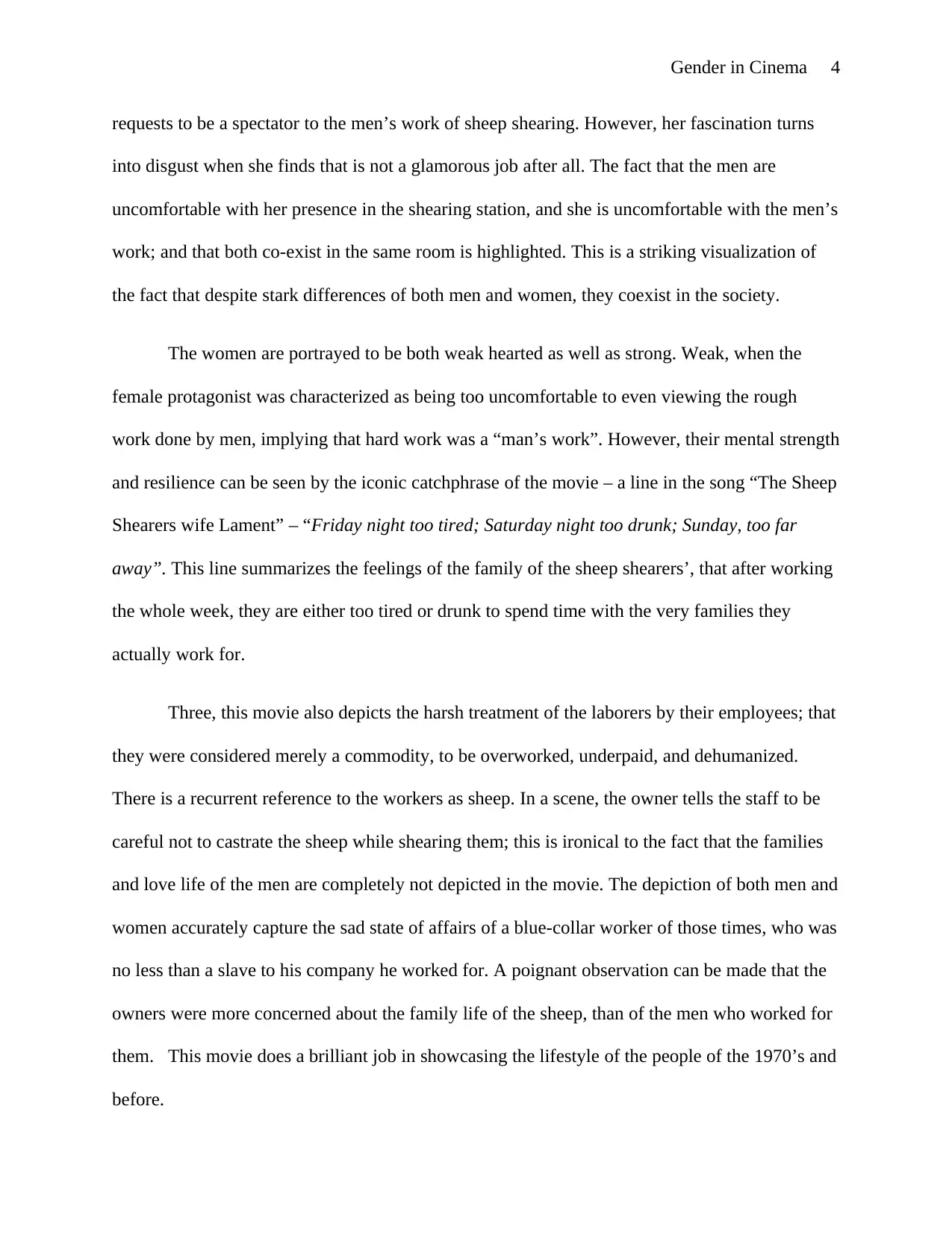
Gender in Cinema 4
requests to be a spectator to the men’s work of sheep shearing. However, her fascination turns
into disgust when she finds that is not a glamorous job after all. The fact that the men are
uncomfortable with her presence in the shearing station, and she is uncomfortable with the men’s
work; and that both co-exist in the same room is highlighted. This is a striking visualization of
the fact that despite stark differences of both men and women, they coexist in the society.
The women are portrayed to be both weak hearted as well as strong. Weak, when the
female protagonist was characterized as being too uncomfortable to even viewing the rough
work done by men, implying that hard work was a “man’s work”. However, their mental strength
and resilience can be seen by the iconic catchphrase of the movie – a line in the song “The Sheep
Shearers wife Lament” – “Friday night too tired; Saturday night too drunk; Sunday, too far
away”. This line summarizes the feelings of the family of the sheep shearers’, that after working
the whole week, they are either too tired or drunk to spend time with the very families they
actually work for.
Three, this movie also depicts the harsh treatment of the laborers by their employees; that
they were considered merely a commodity, to be overworked, underpaid, and dehumanized.
There is a recurrent reference to the workers as sheep. In a scene, the owner tells the staff to be
careful not to castrate the sheep while shearing them; this is ironical to the fact that the families
and love life of the men are completely not depicted in the movie. The depiction of both men and
women accurately capture the sad state of affairs of a blue-collar worker of those times, who was
no less than a slave to his company he worked for. A poignant observation can be made that the
owners were more concerned about the family life of the sheep, than of the men who worked for
them. This movie does a brilliant job in showcasing the lifestyle of the people of the 1970’s and
before.
requests to be a spectator to the men’s work of sheep shearing. However, her fascination turns
into disgust when she finds that is not a glamorous job after all. The fact that the men are
uncomfortable with her presence in the shearing station, and she is uncomfortable with the men’s
work; and that both co-exist in the same room is highlighted. This is a striking visualization of
the fact that despite stark differences of both men and women, they coexist in the society.
The women are portrayed to be both weak hearted as well as strong. Weak, when the
female protagonist was characterized as being too uncomfortable to even viewing the rough
work done by men, implying that hard work was a “man’s work”. However, their mental strength
and resilience can be seen by the iconic catchphrase of the movie – a line in the song “The Sheep
Shearers wife Lament” – “Friday night too tired; Saturday night too drunk; Sunday, too far
away”. This line summarizes the feelings of the family of the sheep shearers’, that after working
the whole week, they are either too tired or drunk to spend time with the very families they
actually work for.
Three, this movie also depicts the harsh treatment of the laborers by their employees; that
they were considered merely a commodity, to be overworked, underpaid, and dehumanized.
There is a recurrent reference to the workers as sheep. In a scene, the owner tells the staff to be
careful not to castrate the sheep while shearing them; this is ironical to the fact that the families
and love life of the men are completely not depicted in the movie. The depiction of both men and
women accurately capture the sad state of affairs of a blue-collar worker of those times, who was
no less than a slave to his company he worked for. A poignant observation can be made that the
owners were more concerned about the family life of the sheep, than of the men who worked for
them. This movie does a brilliant job in showcasing the lifestyle of the people of the 1970’s and
before.
Paraphrase This Document
Need a fresh take? Get an instant paraphrase of this document with our AI Paraphraser
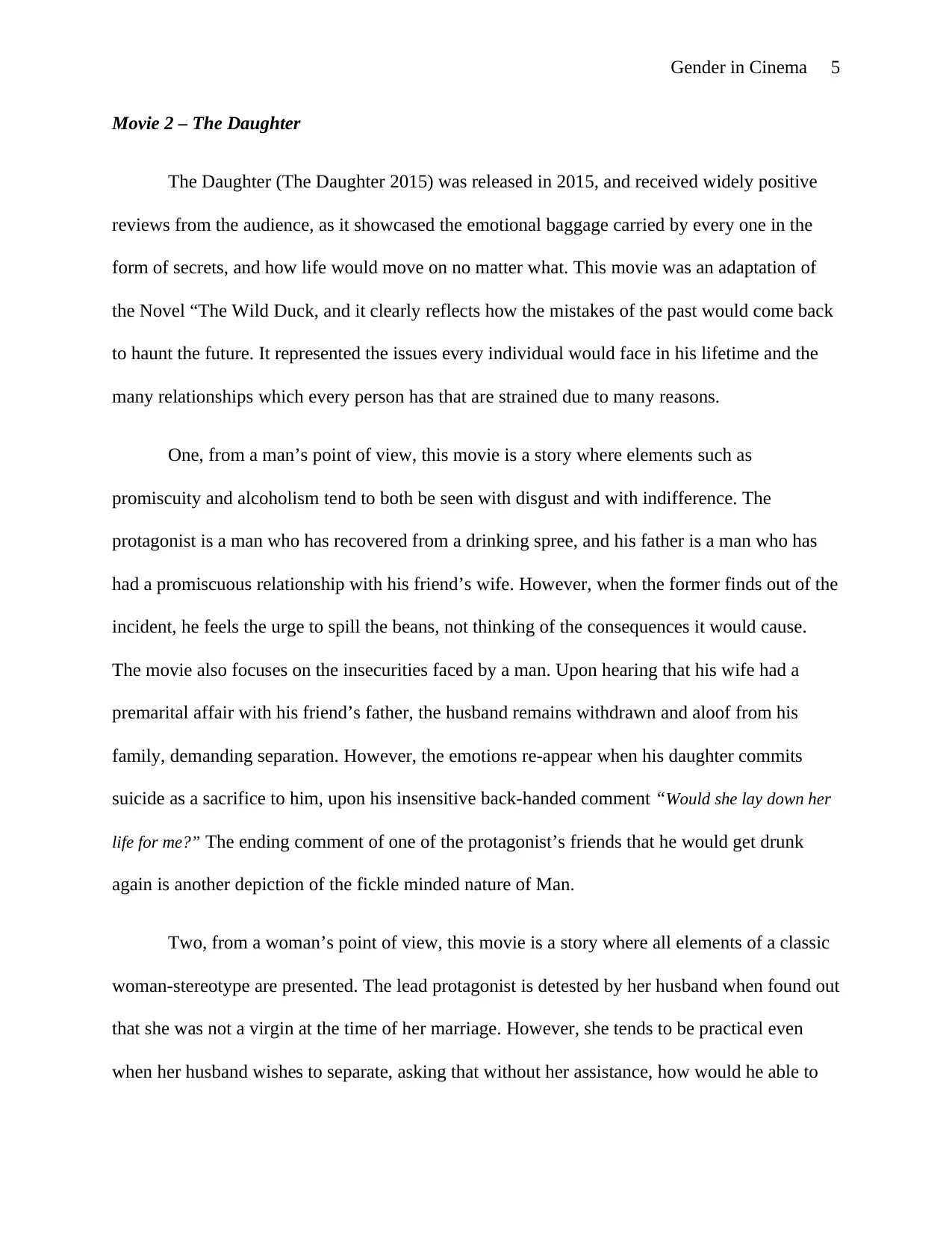
Gender in Cinema 5
Movie 2 – The Daughter
The Daughter (The Daughter 2015) was released in 2015, and received widely positive
reviews from the audience, as it showcased the emotional baggage carried by every one in the
form of secrets, and how life would move on no matter what. This movie was an adaptation of
the Novel “The Wild Duck, and it clearly reflects how the mistakes of the past would come back
to haunt the future. It represented the issues every individual would face in his lifetime and the
many relationships which every person has that are strained due to many reasons.
One, from a man’s point of view, this movie is a story where elements such as
promiscuity and alcoholism tend to both be seen with disgust and with indifference. The
protagonist is a man who has recovered from a drinking spree, and his father is a man who has
had a promiscuous relationship with his friend’s wife. However, when the former finds out of the
incident, he feels the urge to spill the beans, not thinking of the consequences it would cause.
The movie also focuses on the insecurities faced by a man. Upon hearing that his wife had a
premarital affair with his friend’s father, the husband remains withdrawn and aloof from his
family, demanding separation. However, the emotions re-appear when his daughter commits
suicide as a sacrifice to him, upon his insensitive back-handed comment “Would she lay down her
life for me?” The ending comment of one of the protagonist’s friends that he would get drunk
again is another depiction of the fickle minded nature of Man.
Two, from a woman’s point of view, this movie is a story where all elements of a classic
woman-stereotype are presented. The lead protagonist is detested by her husband when found out
that she was not a virgin at the time of her marriage. However, she tends to be practical even
when her husband wishes to separate, asking that without her assistance, how would he able to
Movie 2 – The Daughter
The Daughter (The Daughter 2015) was released in 2015, and received widely positive
reviews from the audience, as it showcased the emotional baggage carried by every one in the
form of secrets, and how life would move on no matter what. This movie was an adaptation of
the Novel “The Wild Duck, and it clearly reflects how the mistakes of the past would come back
to haunt the future. It represented the issues every individual would face in his lifetime and the
many relationships which every person has that are strained due to many reasons.
One, from a man’s point of view, this movie is a story where elements such as
promiscuity and alcoholism tend to both be seen with disgust and with indifference. The
protagonist is a man who has recovered from a drinking spree, and his father is a man who has
had a promiscuous relationship with his friend’s wife. However, when the former finds out of the
incident, he feels the urge to spill the beans, not thinking of the consequences it would cause.
The movie also focuses on the insecurities faced by a man. Upon hearing that his wife had a
premarital affair with his friend’s father, the husband remains withdrawn and aloof from his
family, demanding separation. However, the emotions re-appear when his daughter commits
suicide as a sacrifice to him, upon his insensitive back-handed comment “Would she lay down her
life for me?” The ending comment of one of the protagonist’s friends that he would get drunk
again is another depiction of the fickle minded nature of Man.
Two, from a woman’s point of view, this movie is a story where all elements of a classic
woman-stereotype are presented. The lead protagonist is detested by her husband when found out
that she was not a virgin at the time of her marriage. However, she tends to be practical even
when her husband wishes to separate, asking that without her assistance, how would he able to
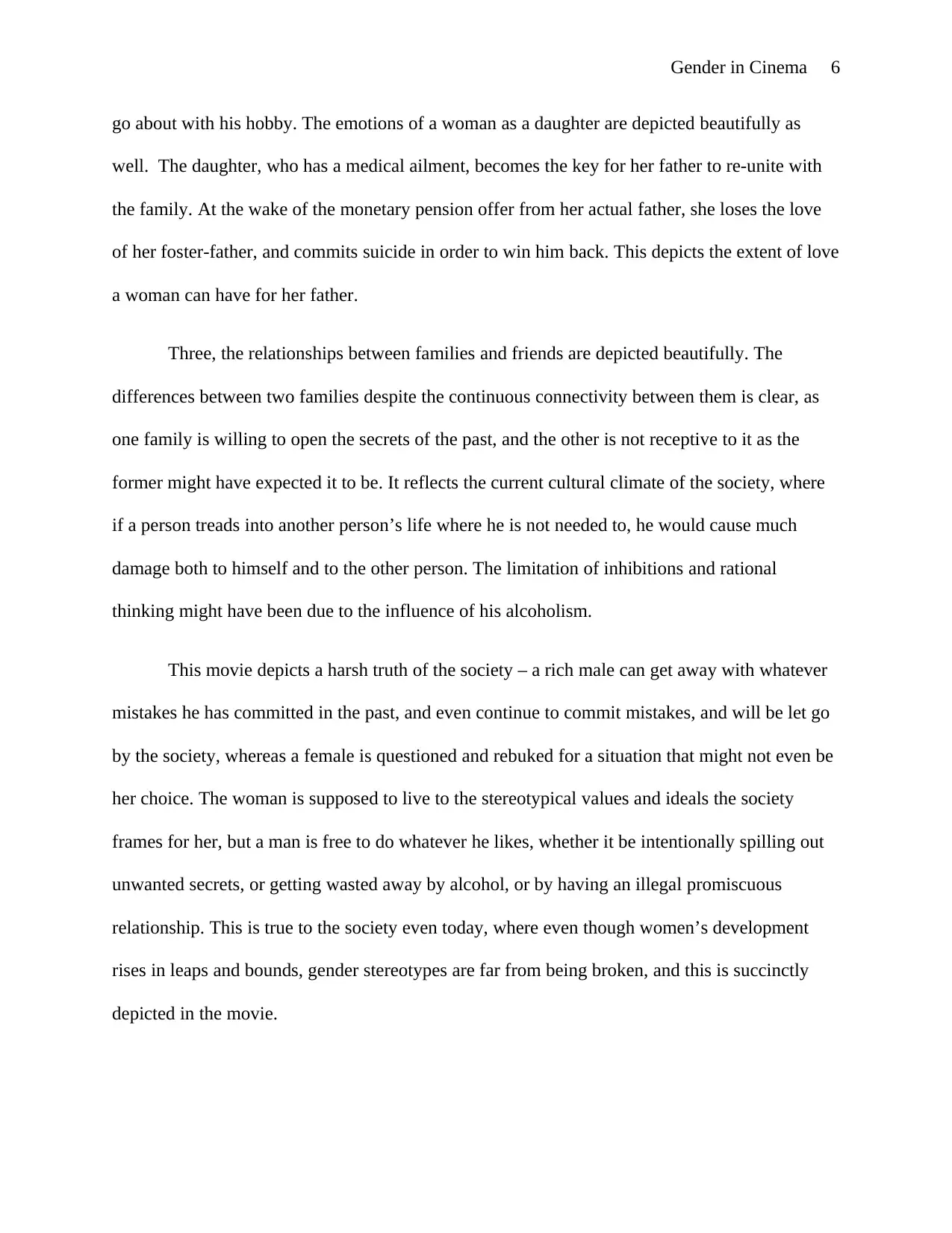
Gender in Cinema 6
go about with his hobby. The emotions of a woman as a daughter are depicted beautifully as
well. The daughter, who has a medical ailment, becomes the key for her father to re-unite with
the family. At the wake of the monetary pension offer from her actual father, she loses the love
of her foster-father, and commits suicide in order to win him back. This depicts the extent of love
a woman can have for her father.
Three, the relationships between families and friends are depicted beautifully. The
differences between two families despite the continuous connectivity between them is clear, as
one family is willing to open the secrets of the past, and the other is not receptive to it as the
former might have expected it to be. It reflects the current cultural climate of the society, where
if a person treads into another person’s life where he is not needed to, he would cause much
damage both to himself and to the other person. The limitation of inhibitions and rational
thinking might have been due to the influence of his alcoholism.
This movie depicts a harsh truth of the society – a rich male can get away with whatever
mistakes he has committed in the past, and even continue to commit mistakes, and will be let go
by the society, whereas a female is questioned and rebuked for a situation that might not even be
her choice. The woman is supposed to live to the stereotypical values and ideals the society
frames for her, but a man is free to do whatever he likes, whether it be intentionally spilling out
unwanted secrets, or getting wasted away by alcohol, or by having an illegal promiscuous
relationship. This is true to the society even today, where even though women’s development
rises in leaps and bounds, gender stereotypes are far from being broken, and this is succinctly
depicted in the movie.
go about with his hobby. The emotions of a woman as a daughter are depicted beautifully as
well. The daughter, who has a medical ailment, becomes the key for her father to re-unite with
the family. At the wake of the monetary pension offer from her actual father, she loses the love
of her foster-father, and commits suicide in order to win him back. This depicts the extent of love
a woman can have for her father.
Three, the relationships between families and friends are depicted beautifully. The
differences between two families despite the continuous connectivity between them is clear, as
one family is willing to open the secrets of the past, and the other is not receptive to it as the
former might have expected it to be. It reflects the current cultural climate of the society, where
if a person treads into another person’s life where he is not needed to, he would cause much
damage both to himself and to the other person. The limitation of inhibitions and rational
thinking might have been due to the influence of his alcoholism.
This movie depicts a harsh truth of the society – a rich male can get away with whatever
mistakes he has committed in the past, and even continue to commit mistakes, and will be let go
by the society, whereas a female is questioned and rebuked for a situation that might not even be
her choice. The woman is supposed to live to the stereotypical values and ideals the society
frames for her, but a man is free to do whatever he likes, whether it be intentionally spilling out
unwanted secrets, or getting wasted away by alcohol, or by having an illegal promiscuous
relationship. This is true to the society even today, where even though women’s development
rises in leaps and bounds, gender stereotypes are far from being broken, and this is succinctly
depicted in the movie.
⊘ This is a preview!⊘
Do you want full access?
Subscribe today to unlock all pages.

Trusted by 1+ million students worldwide
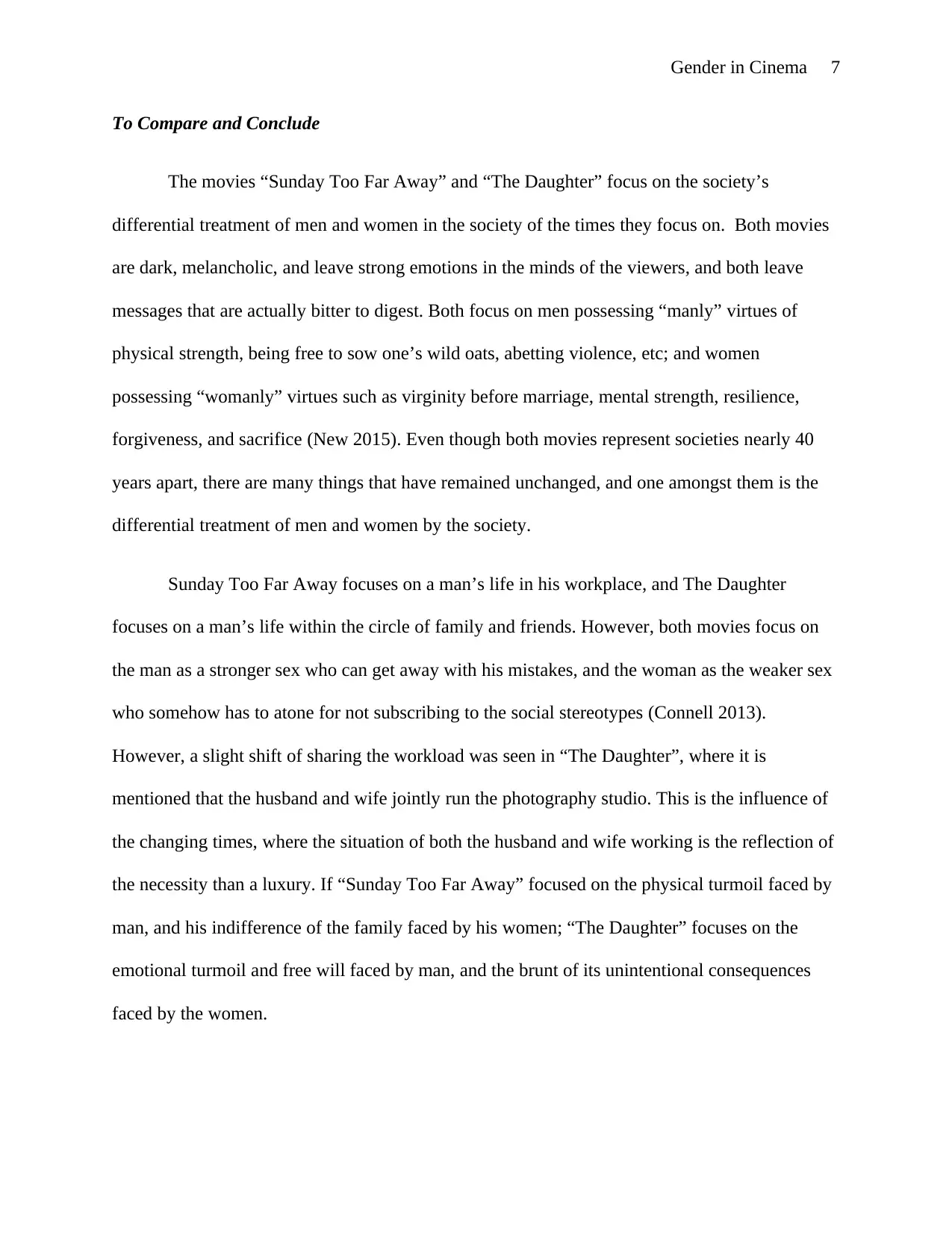
Gender in Cinema 7
To Compare and Conclude
The movies “Sunday Too Far Away” and “The Daughter” focus on the society’s
differential treatment of men and women in the society of the times they focus on. Both movies
are dark, melancholic, and leave strong emotions in the minds of the viewers, and both leave
messages that are actually bitter to digest. Both focus on men possessing “manly” virtues of
physical strength, being free to sow one’s wild oats, abetting violence, etc; and women
possessing “womanly” virtues such as virginity before marriage, mental strength, resilience,
forgiveness, and sacrifice (New 2015). Even though both movies represent societies nearly 40
years apart, there are many things that have remained unchanged, and one amongst them is the
differential treatment of men and women by the society.
Sunday Too Far Away focuses on a man’s life in his workplace, and The Daughter
focuses on a man’s life within the circle of family and friends. However, both movies focus on
the man as a stronger sex who can get away with his mistakes, and the woman as the weaker sex
who somehow has to atone for not subscribing to the social stereotypes (Connell 2013).
However, a slight shift of sharing the workload was seen in “The Daughter”, where it is
mentioned that the husband and wife jointly run the photography studio. This is the influence of
the changing times, where the situation of both the husband and wife working is the reflection of
the necessity than a luxury. If “Sunday Too Far Away” focused on the physical turmoil faced by
man, and his indifference of the family faced by his women; “The Daughter” focuses on the
emotional turmoil and free will faced by man, and the brunt of its unintentional consequences
faced by the women.
To Compare and Conclude
The movies “Sunday Too Far Away” and “The Daughter” focus on the society’s
differential treatment of men and women in the society of the times they focus on. Both movies
are dark, melancholic, and leave strong emotions in the minds of the viewers, and both leave
messages that are actually bitter to digest. Both focus on men possessing “manly” virtues of
physical strength, being free to sow one’s wild oats, abetting violence, etc; and women
possessing “womanly” virtues such as virginity before marriage, mental strength, resilience,
forgiveness, and sacrifice (New 2015). Even though both movies represent societies nearly 40
years apart, there are many things that have remained unchanged, and one amongst them is the
differential treatment of men and women by the society.
Sunday Too Far Away focuses on a man’s life in his workplace, and The Daughter
focuses on a man’s life within the circle of family and friends. However, both movies focus on
the man as a stronger sex who can get away with his mistakes, and the woman as the weaker sex
who somehow has to atone for not subscribing to the social stereotypes (Connell 2013).
However, a slight shift of sharing the workload was seen in “The Daughter”, where it is
mentioned that the husband and wife jointly run the photography studio. This is the influence of
the changing times, where the situation of both the husband and wife working is the reflection of
the necessity than a luxury. If “Sunday Too Far Away” focused on the physical turmoil faced by
man, and his indifference of the family faced by his women; “The Daughter” focuses on the
emotional turmoil and free will faced by man, and the brunt of its unintentional consequences
faced by the women.
Paraphrase This Document
Need a fresh take? Get an instant paraphrase of this document with our AI Paraphraser
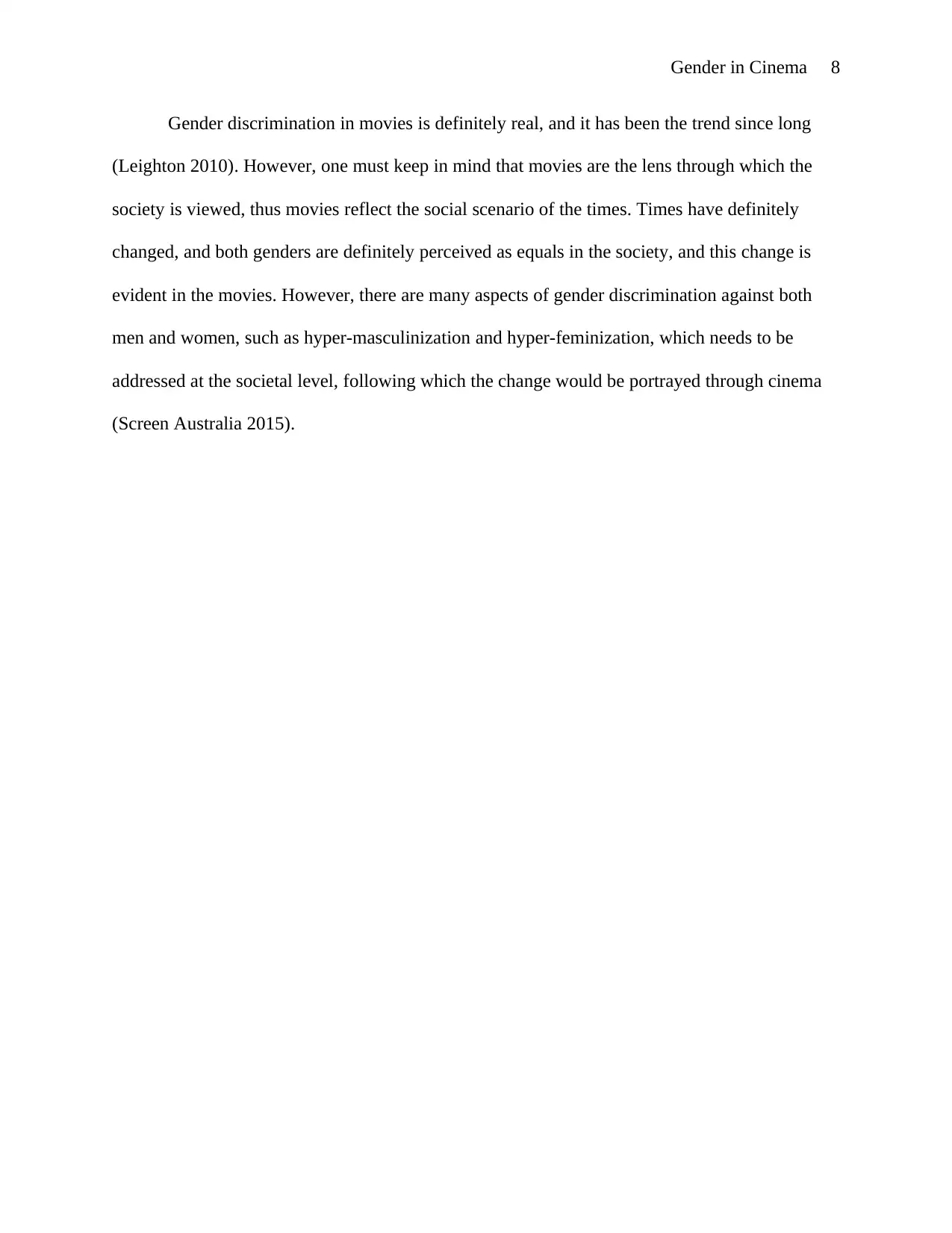
Gender in Cinema 8
Gender discrimination in movies is definitely real, and it has been the trend since long
(Leighton 2010). However, one must keep in mind that movies are the lens through which the
society is viewed, thus movies reflect the social scenario of the times. Times have definitely
changed, and both genders are definitely perceived as equals in the society, and this change is
evident in the movies. However, there are many aspects of gender discrimination against both
men and women, such as hyper-masculinization and hyper-feminization, which needs to be
addressed at the societal level, following which the change would be portrayed through cinema
(Screen Australia 2015).
Gender discrimination in movies is definitely real, and it has been the trend since long
(Leighton 2010). However, one must keep in mind that movies are the lens through which the
society is viewed, thus movies reflect the social scenario of the times. Times have definitely
changed, and both genders are definitely perceived as equals in the society, and this change is
evident in the movies. However, there are many aspects of gender discrimination against both
men and women, such as hyper-masculinization and hyper-feminization, which needs to be
addressed at the societal level, following which the change would be portrayed through cinema
(Screen Australia 2015).
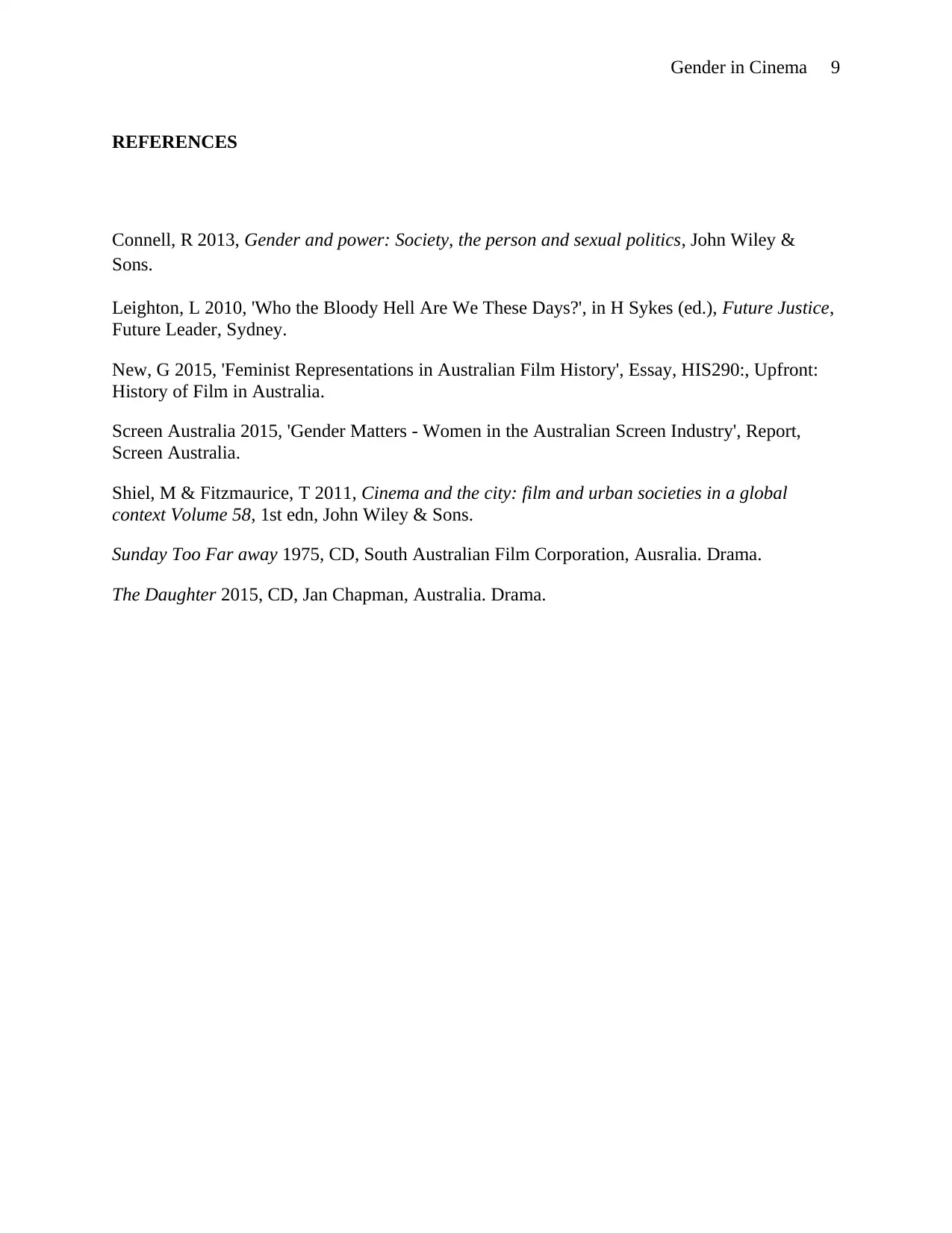
Gender in Cinema 9
REFERENCES
Connell, R 2013, Gender and power: Society, the person and sexual politics, John Wiley &
Sons.
Leighton, L 2010, 'Who the Bloody Hell Are We These Days?', in H Sykes (ed.), Future Justice,
Future Leader, Sydney.
New, G 2015, 'Feminist Representations in Australian Film History', Essay, HIS290:, Upfront:
History of Film in Australia.
Screen Australia 2015, 'Gender Matters - Women in the Australian Screen Industry', Report,
Screen Australia.
Shiel, M & Fitzmaurice, T 2011, Cinema and the city: film and urban societies in a global
context Volume 58, 1st edn, John Wiley & Sons.
Sunday Too Far away 1975, CD, South Australian Film Corporation, Ausralia. Drama.
The Daughter 2015, CD, Jan Chapman, Australia. Drama.
REFERENCES
Connell, R 2013, Gender and power: Society, the person and sexual politics, John Wiley &
Sons.
Leighton, L 2010, 'Who the Bloody Hell Are We These Days?', in H Sykes (ed.), Future Justice,
Future Leader, Sydney.
New, G 2015, 'Feminist Representations in Australian Film History', Essay, HIS290:, Upfront:
History of Film in Australia.
Screen Australia 2015, 'Gender Matters - Women in the Australian Screen Industry', Report,
Screen Australia.
Shiel, M & Fitzmaurice, T 2011, Cinema and the city: film and urban societies in a global
context Volume 58, 1st edn, John Wiley & Sons.
Sunday Too Far away 1975, CD, South Australian Film Corporation, Ausralia. Drama.
The Daughter 2015, CD, Jan Chapman, Australia. Drama.
⊘ This is a preview!⊘
Do you want full access?
Subscribe today to unlock all pages.

Trusted by 1+ million students worldwide
1 out of 9
Your All-in-One AI-Powered Toolkit for Academic Success.
+13062052269
info@desklib.com
Available 24*7 on WhatsApp / Email
![[object Object]](/_next/static/media/star-bottom.7253800d.svg)
Unlock your academic potential
Copyright © 2020–2025 A2Z Services. All Rights Reserved. Developed and managed by ZUCOL.